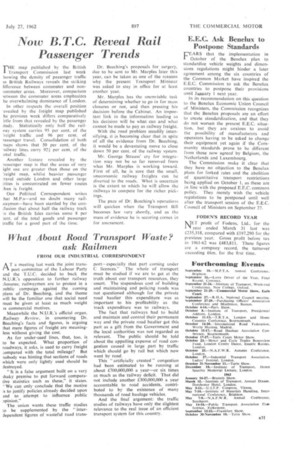Now B.T.C. Reveal Rail Passenger Trends
Page 39

If you've noticed an error in this article please click here to report it so we can fix it.
THE map published by the British Transport Commission last week bowing the density of passenger traffic m British Railways reveals the striking lifference between commuter and non:ommuter areas. Moreover, comparison )etween the commuter areas emphasizes he overwhelming dominance of London.
In other respects the overall position .evealed by the freight map published he previous week differs comparatively ittle from that revealed by the passenger ffudy. Statistically only half the railway system carries 95 per cent. of the 'reight traffic and 96 per cent, of Jassenger travel. Consolidation of both naps shows that 50 per cent. of the -ailway lines carry 92per cent, of the :Mal traffic.
Another feature revealed by the aassenger map is that the areas of very ight use are greater than those on the 'reight map, whilst heavier passenger :ravel outside London and other large cities is concentrated on fewer routes :han is freight.
Our political Correspondent writes :hat M.P.s—and no doubt many railafaymen—have been startled by the conclusion that about half the railway track :n the British Isles carries some 8 per cent. of the total goods and passenger traffic for a good part of the time.
Dr. Beeching's proposals for surgery, due to be sent to Mr. Marples later this year, can be taken as one of the reasons why the present Transport Minister was asked to stay in office for at least another year.
Mr. Marples has the unenviable task of determining whether to go in for mass closures or not, and then pressing his decision before the Cabinet. An important link in the information leading to his decision will be what can and what cannot be made to pay as railway freight.
With the road problem steadily intensifying, it is becoming clear that in spite of all the evidence from Dr. Beeching, it would be a devastating move to close down 50 per cent. of the railway system Mr. George Strauss' cry for integration may not be so far removed from what Mr. Marples is working toward. First of all, he is sure that the small, uneconomic railway freights can be diverted to the roads. What is uncertain is the extent to which he will allow the railways to compete for the richer pickings.
The pace of Dr. Beeching's operations will quicken when the Transport Bill becomes law very shortly, and as the mass of evidence he is securing comes in for assessment.
































































































































